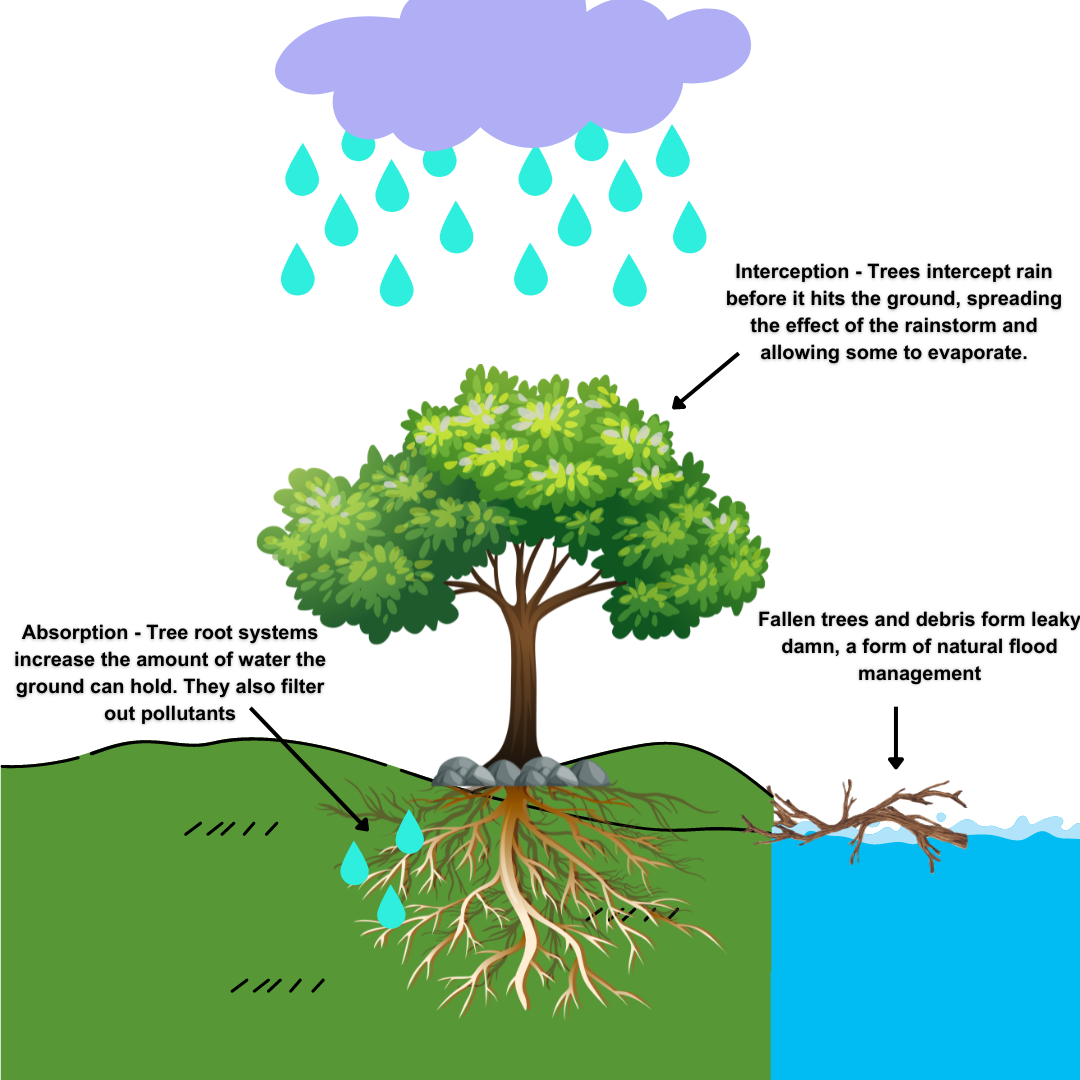National Tree Week — The Many Benefits of Trees
In our continued celebration of trees, we are looking at how they benefit water quality, reduce the impact of flooding, and create vital habitats.
30/11/22
It’s National Tree Week and we want to celebrate by highlighting the plethora of benefits that come with planting trees. We frequently hear about their ability to store carbon and help cool the planet, but we want to focus on what trees can do for rivers, the surrounding land, and our overall water quality.
Flood protection
As climate change continues to progress, we are seeing extreme weather events becoming more frequent and more severe. This year alone, we have seen both droughts and flooding. Along with their cooling effect, trees can help prevent and mitigate flooding and are a useful method of natural flood management (NFM). They can do this by both interception and absorption.
Interception is when rain hits trees before the ground and collects on the leaves, trunk, and branches. This effectively slows the rainstorm down and spreads it out over a longer period. Not only does this provide more time for water to be absorbed by the soil, but it also enables some to be evaporated back into the atmosphere.
Absorption refers to the act of trees taking up water from the soil via their roots. This ultimately increases the amount of water that the ground can hold, thereby reducing the likelihood and severity of flooding. A study found that, compared to turf, trees increase initial water infiltration rates by 53-300% and steady rates by 89-2167% [1]. Trees with deeper roots have a greater impact on these rates than those with shallower root systems. This is a substantial effect and emphasises the need for more trees in flood-prone areas.
Additionally, debris and fallen trees can form leaky dams. These slow the flow of water and temporarily store water. This can help reduce the flood peak and distribute the water more evenly, ultimately acting as another form of natural flood management. It is so effective that lots of our member Trusts manually install woody debris to form leaky damns, helping to reduce flood risk.
Water quality
Pollution in our water systems is becoming an ever more serious issue with sewage from drain overflows and agricultural run-off causing significant problems for our aquatic ecosystems. Heavy rain can wash these pollutants into nearby bodies of water. The nitrate and phosphorous-rich agricultural run-off can alter water chemistry and cause substantial algal growth, reducing the oxygen levels in the ecosystem and ultimately killing other organisms (a processes known as eutrophication).
However, a barrier of trees either surrounding farmland or along the banks of rivers can mitigate these effects. The trees and vegetation forming this barrier, sometimes referred to as a “buffer zone”, can make use of the nutrients, absorbing them before they reach the water. A study testing surface water quality found that a narrow 6-meter buffer zone, composed of 5 meters of grass and 1 meter of trees, removed almost 100% of dissolved phosphorous [2]. Additionally, in most cases the water leaving the buffer zone would be unlikely to cause eutrophication.
Healthy rivers and banks
If flood protection and water quality improvements weren’t enough, trees can also protect and improve river habitats in several ways. Firstly, tree roots help secure riverbanks, making them more resistant to erosion and less prone to collapsing. Secondly, the presence of trees provides rivers with shade, keeping them and their inhabitants cool.

Conclusion
Trees are fantastic! Both for the natural world and for us. Not only do they provide habitats and ecosystems of their own, but they support the life in our water systems. Combined with their unmatched ability to provide natural flood management and water purification, it is safe to say that we could use more of them. For natural tree week, take some time to appreciate our trees and marvel at what they are capable of. We haven’t even covered the mental health benefits of being among them. You can learn more about our tree planting efforts here.
References
[1] Borin, M., Bigon, E., Zanin, G. and Fava, L., 2004. Performance of a narrow buffer strip in abating agricultural pollutants in the shallow subsurface water flux. Environmental Pollution, 131(2), pp.313-321.
[2] Xie, C., Cai, S., Yu, B., Yan, L., Liang, A. and Che, S., 2020. The effects of tree root density on water infiltration in urban soil based on a Ground Penetrating Radar in Shanghai, China. Urban Forestry & Urban Greening, 50, p.126648.